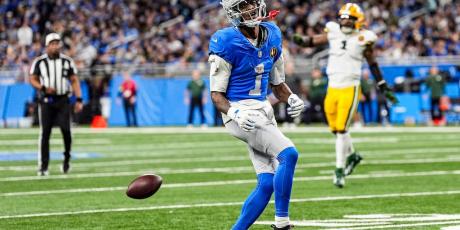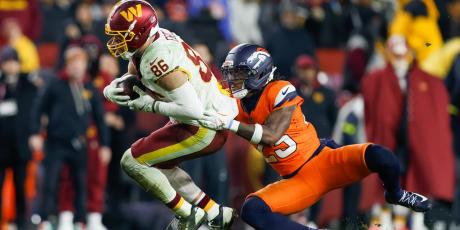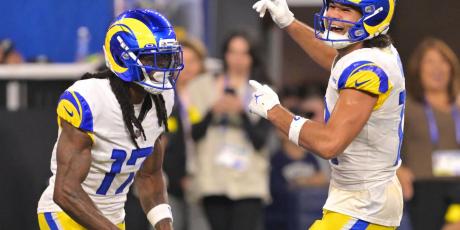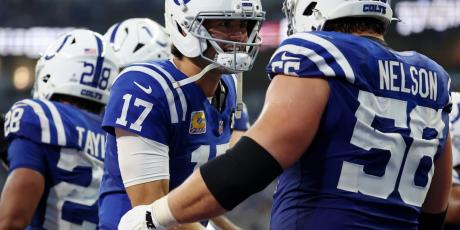Analyzing a 2025 Salary Cap Mock Draft (July)
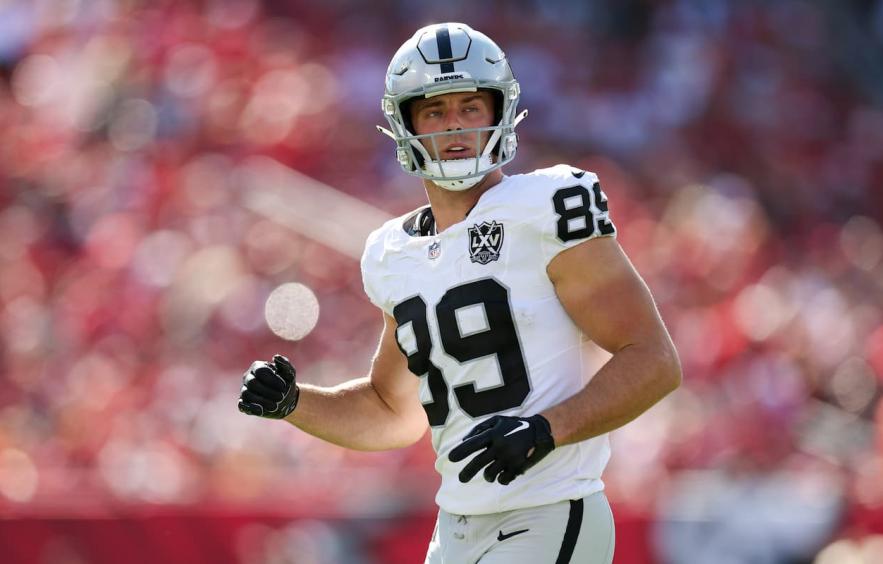
Across the broad spectrum of fantasy formats available in the modern day, few are harder to strategize and practice for than salary cap drafts. Every salary cap draft is different; their flow and outcome are heavily dictated by the managers in your league, and one or two moves can completely change the landscape of your roster in ways that they simply would not in typical snake drafts.

DraftKings is giving ALL customers a can't-miss offer for Best Ball: Draft One, Get One! Enter a lineup in the $15 Million Best Ball Contest for just $20, and you'll score another Best Ball ticket to play FREE for a share of $15 million—giving you a second shot to win big!
As such, when analyzing any particular salary cap mock draft, it’s rarely useful to identify specific takeaways or strategic angles with the goal of applying them carte blanche across the format. Instead, salary cap mocks are best used for a few specific purposes.
1. Practice. While it may not “make perfect” in fantasy football, practice will “make better.”
2. Comfort. The greatest danger in salary cap drafts is overreacting, panicking, or generally losing your cool. It’s a slippery slope that will lead to more mistakes. So being comfortable and familiar with the ups and downs of the format is crucial.
3. Exposure. Salary cap drafts can go so many different directions (so quickly) that learning all the possible avenues means you’re less likely to get backed into a corner on draft day.
With all this context in mind, we’re going to dive into a 12-team salary cap mock draft, run at the start of July, to help provide you with some of that exposure and give you some “film” to study the inner workings of the format.
For settings, we went with a pretty typical roster setup — QB, RB, RB, WR, WR, TE, FLEX, FLEX, and six bench spots — half-PPR scoring, and a $200 salary cap. You can scan the full draft results at the end of the article, and get the “film analysis” in between.
Roster Construction
Studs & Scrubs
Three teams in the draft — curiously, Team 4, Team 5, and Team 6 — invested heavily into the "Studs & Scrubs" strategy by drafting three players at $40+ to form the core of their squads.
| Team 4 | Team 5 | Team 6 |
| RB Jahmyr Gibbs ($44) | RB Bijan Robinson ($50) | WR Ja'Marr Chase ($64) |
| WR Puka Nacua ($44) | RB Saquon Barkley ($48) | WR Justin Jefferson ($48) |
| WR Malik Nabers ($41) | RB Derrick Henry ($48) | WR CeeDee Lamb ($48) |
The Studs & Scrubs strategy is perhaps one of the most exhilarating in all of fantasy football, as you can land an absolutely absurd nucleus of superstars that would be utterly impossible in a snake draft. According to the current Underdog ADP, all three of these teams drafted three top-15 overall players, and Team 6 compiled the top three wide receivers in fantasy all on the same team. This, truly, is where salary cap drafts shine: the diversity of roster construction strategies blows typical fantasy drafts out of the water.
Of course, there is a tradeoff for this type of "all in" approach. These three teams spent 64%, 73%, and 80% of their total budget (respectively) on just three players. After landing their wide receiver super trio, Team 6 has just $40 left for the remaining 14 spots on their roster. To put this into even starker perspective, a more "balanced" squad like Team 3 — whose most expensive player was Jayden Daniels at $32 — spent just $86 on their top three players and had $114 remaining for the rest of the roster.
And, as a result, the rest of these rosters are ... questionable at best. Team 4 is staring at Trey Benson ($3) as their RB2, Team 5 will likely be starting the rookie duo of Tetairoa McMillan ($5) and Travis Hunter ($7) at wide receiver, and Team 6 is rocking with J.J. McCarthy ($1) at QB and Ray Davis ($4) at RB2. Are their studs enough to carry their balance of scrubs? Maybe. In last year's version of this column, one of the Studs & Scrubs teams picked up Jayden Daniels for $3, Brock Bowers for $5, and Ladd McConkey for $3 — nailing the rookie class and likely setting up for a championship run.
Regardless, these sorts of strategies are what make salary cap drafts so intriguing. And this is a perfect example of what mock drafts can offer: a glimpse of the glory you can achieve up top ... and the grime it leaves you with down below.
Balance, Balance, Balance
In this mock, only one team picked up more than five players between $10 and $30, forming what I consider the peak of the "Balanced" roster strategy. This was quite a departure from last year's mock, which saw three different teams draft at least eight such players. This year, it was Team 3, who we referenced above, and who drafted eight players in the $10-30 price range, plus Daniels at $32 for their QB.
| Players |
|---|
| RB Chuba Hubbard ($28) |
| RB Brian Robinson ($23) |
| WR Jaxon Smith-Njigba ($26) |
| WR Garrett Wilson ($23) |
| TE Mark Andrews ($10) |
| WR Xavier Worthy ($16) |
| RB Jaylen Warren ($13) |
| WR Jaylen Waddle ($11) |
With the exception of Daniels — who just missed the mark at $32 — Team 3's entire starting roster (and one extra FLEX) is priced in between $10 and $30 apiece. Quite a rare feat, and incredibly opposite of the Studs & Scrubs rosters above. They're the only team that will not be starting a sub-$10 player somewhere in their lineup (based on initial draft values). Their top bench player — likely one of the Jaylen W's — costs more than either starting running back for Team 6 (Quinshon Judkins and Ray Davis).
And, as with the Studs & Scrubs, this approach can result in rather "un-snakeable" builds. Team 3 does not have a single player currently drafted in the first two rounds of Underdog ADP, but they have six players going in Rounds 3-5. If you're intent on building stacks, this is a good way to do it (and Team 3 could have if they'd substituted Terry McLaurin for Smith-Njigba).
Position Pirates
A couple of teams indexed very heavily into a single position, putting together some formidable RB or WR rooms, while poaching those players from other teams in need. Another wrinkle of salary cap drafts is that you can pull this off more aggressively, since you don’t have to rely on the “right guys” being on the board when the snake returns to you, but can pay what you want, for who you want, whenever you want.
At running back, the aforementioned Team 5 obviously takes the cake — spending $148 on their top three RBs and $163 on the position in full — but Team 1 also dropped an impressive $158 on an incredibly deep stable of eight backs.
| Team 1 | Team 5 |
|---|---|
| Christian McCaffrey ($42) | Bijan Robinson ($50) |
| Ashton Jeanty ($34) | Saquon Barkley ($50) |
| Chase Brown ($32) | Derrick Henry ($48) |
| Omarion Hampton ($18) | Kaleb Johnson ($8) |
| Rhamondre Stevenson ($14) | Tank Bigsby ($4) |
| RJ Harvey ($10) | Kareem Hunt ($3) |
| Tyjae Spears ($6) | |
| J.K. Dobbins ($2) | |
| Total: $158 | Total: $163 |
Unsurprisingly, both teams are rather thin elsewhere. Neither team is sporting a wideout worth more than $12 (aka Calvin Ridley, the most expensive WR on either roster), and their tight ends are Jake Ferguson ($2) and Jonnu Smith ($3), respectively.
Meanwhile, Team 4 and Team 9 each drafted at least six wide receivers and spent upwards of $135 apiece on the position. (I'm leaving Team 6 out of this section; while they spent $167 on wide receivers, it was all on just four players.)
| Team 4 | Team 9 |
|---|---|
| Puka Nacua ($44) | Nico Collins ($42) |
| Malik Nabers ($41) | Ladd McConkey ($33) |
| Amon-Ra St. Brown ($41) | Tee Higgins ($31) |
| Darnell Mooney ($4) | Terry McLaurin ($27) |
| Keon Coleman ($3) | Jakobi Meyers ($9) |
| Michael Pittman Jr. ($2) | Rome Odunze ($7) |
| Rashod Bateman ($1) | |
| Total: $136 | Total: $149 |
Team 4 came away with three of the top seven wide receivers by current ADP, and Team 9 compiled the WR6, WR11, WR14, and WR18 (among others), all four of whom would typically be drafted in the first three rounds of a snake draft. Once again, of course, there is a price to pay (beyond the actual salary cap price). Team 4's RB depth chart past Jahmyr Gibbs is abysmal — Trey Benson, Bhayshul Tuten, Jaydon Blue, and Ollie Gordon II — and Team 9's entire RB room is worth a grand total of $30.
Team 11 also deserves a special shout-out for their three-man dip into the tight end position. They spent $28 on Brock Bowers — a potential value, considering Trey McBride went for $31 and George Kittle went for $26 — and then proceeded to drop an additional $10 on Sam LaPorta and $4 on Evan Engram ($42 total on tight ends). Whether it would work out for them is tough to say, but they did end up monopolizing three of the viable TE1s and making a shallow position much shallower for their opponents.
The “Classic” Build
If you’re wondering what happened with Teams 2, 7, 8, 10, and 12, they each went for some variation of what I'd consider the “Classic" build:
Teams 7 and 12 took the most prototypical approach, each spending:
- Between $65-85 combined on their RB1 and RB2 slots, giving them stable stables (pun intended) to start the season
- Between $45-55 combined on their WR1 and WR2 slots
- Less than $10 on their starting QB
- Roughly $30 on their "expected" FLEX starters
- Less than $20 on their entire benches (below the draft average)
Notably, Team 7 did spend $31 on their starting tight end (Trey McBride) ... and $26 on a backup tight end (George Kittle), who will start in the FLEX. That's a little bit of a departure. Otherwise, both teams are rather "standard," and their rosters tend to look much more like a typical snake draft build.
Teams 8 and 10 built somewhat similarly, except that they went the "Elite QB" version, paying $32 for Lamar Jackson and $29 for Josh Allen, respectively. Team 8 sacrificed a bit in their FLEX spots to pull this off — they're likely starting George Pickens and Tyrone Tracy Jr. (each $11) — and Team 10 has only Dallas Goedert at the tight end position. But all in all, these two builds look very strong, with both depth and upside.
Team 2 stretched the "Classic" build a bit further, investing a little more heavily at WR1 and WR2 — with Brian Thomas Jr. ($35) and Davante Adams ($33) — and paying quite a bit for their bench ($31 in total). I'm personally a big fan of this team, which managed to get Bo Nix for $5 and Kyler Murray for $3, and it might have been my favorite squad overall if they'd abandoned some bench investment to get a better tight end than Colston Loveland ($1).
Valuation Evaluation
If all of the above was a review of where managers spent their salary cap, what about the values they assigned when they spent those dollars? Did the manager who dropped $64 on Ja'Marr Chase — nearly 25% more than the second-most expensive player — strike gold or sink their own ship? Is Justin Herbert really worth just 6% of what Lamar Jackson is worth in salary terms?
The first thing to note is that valuations can vary wildly from draft to draft, typically far more than in snake drafts (unless we’re talking about your family league in Green Bay, where Jordan Love goes in the first round). While players will sometimes go a little earlier than ADP in run-of-the-mill snake drafts, that’s typically because one manager makes a move, leaving the rest of the league with no recourse or response. In salary cap drafts, if two managers really want the same guy, the resulting bidding war can break banks in the blink of an eye. And conversely, if you nominate a mid-round sleeper while the sharps in your league are distracted, you might snag a player for $1 that should have cost five or 10 times that.
All that being said, we can identify some interesting “highlights” in this “film analysis” of a mock draft that should help expose you to the types of values you’re likely to see.
Running it Up on Running Backs
As we saw last year, most of the notable "overpays" in this mock draft were tied to running backs. Consider these comparisons. Nico Collins, Malik Nabers, Amon-Ra St. Brown, and Brian Thomas Jr. all went for fewer than $45 — heck, BTJ went for just $35. Meanwhile, De'Von Achane, Derrick Henry, and Josh Jacobs all went for $45+ ... despite the fact that all three are being drafted after all four of those wideouts in Underdog ADP. Not far behind them, Jonathan Taylor and Bucky Irving went for $41, and Kyren Williams went for $40. Taylor and Irving are going at least six picks later than BTJ, and sometimes a round later than Nabers or Collins, and Williams is being drafted near the back of the third. And all of the running backs mentioned so far went for significantly more than Brock Bowers ($28) and Trey McBride ($31), who are going in that second-round range right around Taylor, Irving, and Jacobs.
Once again, running back feels very top-heavy and drops off very quickly. As a result, we are likely to see some frantic spending sprees on the low-end RB1s and RB2s by managers afraid of missing out on the position entirely. That said, the more important lesson here is that when much of the draft zigs, you have an opportunity to zag for serious value.
For perspective, consider Team 8 and the $74 they spent on Jacobs ($45) and Alvin Kamara ($29), leaving them with Tyreek Hill and Courtland Sutton as their starting WRs. Had Team 8 instead gone with a "discounted" duo like Breece Hall and RJ Harvey at RB, they could have theoretically paired those guys with Malik Nabers and Drake London at WR, with room to spare. Here’s a look at the actual squad and the hypothetical squad, with current ADPs included.
| Actual Roster (Cost / ADP) | Hypothetical Roster (Cost / ADP) |
|---|---|
| RB Josh Jacobs ($45 / 3.01) | Breece Hall ($35 / 2.10) |
| RB Alvin Kamara ($29 / 5.09) | RJ Harvey ($10 / 6.02) |
| WR Tyreek Hill ($29 / 2.11) | Malik Nabers ($41 / 1.09) |
| WR Courtland Sutton ($16 / 5.01) | Drake London ($31 / 2.04) |
| $119 total / 4.03 Average ADP | $117 total / 3.06 Average ADP |
Even with a sixth-round RJ Harvey bringing down their score, the hypothetical roster is nearly a round better in average ADP and includes three players being drafted in the first two rounds, while the actual roster has just one (Hill at 2.11). While Team 8 couldn't have known every possible discount that would be available in this mock, it's hard not to prefer the hypothetical WR-focused version in this scenario.
Passing the Savings On to You
As a result of the RB inflation, several wide receivers, quarterbacks, and tight ends went for what could be considered significant discounts in this mock. Here’s a look at several of the value picks at those positions, with a head-to-head ADP comparison against a running back at the same price.
| Player | Salary Cap Price | Underdog ADP |
|---|---|---|
| QB Joe Burrow | $13 | 6.01 |
| RB Jaylen Warren | $13 | 9.01 |
| Player | Salary Cap Price | Underdog ADP |
|---|---|---|
| WR Puka Nacua | $44 | 1.07 |
| RB Josh Jacobs | $45 | 3.01 |
| Player | Salary Cap Price | Underdog ADP |
|---|---|---|
| TE Brock Bowers | $28 | 2.07 |
| RB D'Andre Swift | $28 | 7.03 |
In this mock, Team 2 picked up Bo Nix ($5), DK Metcalf ($17), and Jameson Williams ($11) for a total of $33 — a dollar less than what Team 11 paid for James Cook alone. And Cook is going one spot ahead of Metcalf in ADP. I'm confident 999 out of 1,000 fantasy managers are trading Cook for that trio on draft day.
The Bottom Line
- No one strategy or roster construction necessarily reigns supreme. One of the highlights of salary cap drafts is that you can build the team you want to build (within reason), and we saw the full range of approaches in this mock.
- With the scarcity and tier drops at running back, we may see some price inflation at the position in 2024. That said, it’s more important to monitor the trends in your actual draft than to apply the runout of this mock across the board.
- It pays big to identify where premiums are being posted and to avoid those traps. If there’s a flurry of overpays on a position in your draft, don’t feel compelled to follow the crowd out of fear. Instead, pivot to the resulting values elsewhere.


